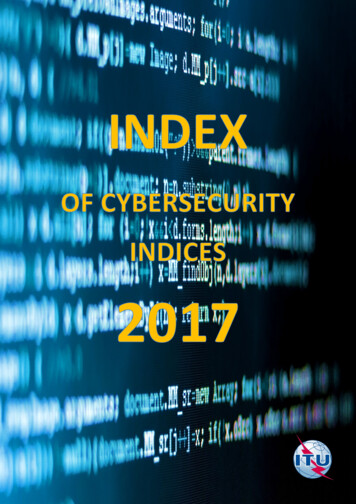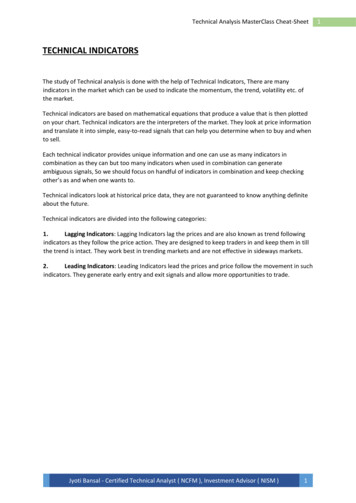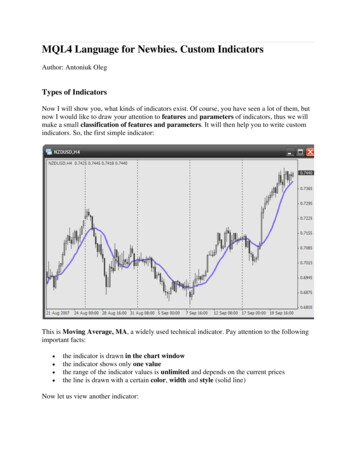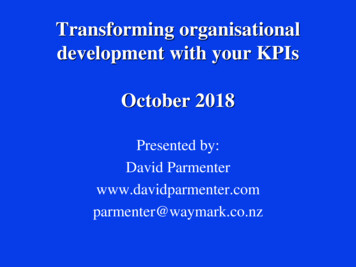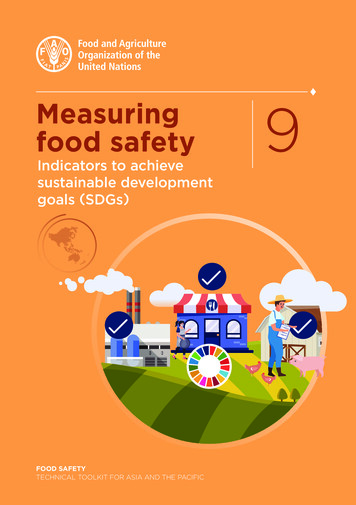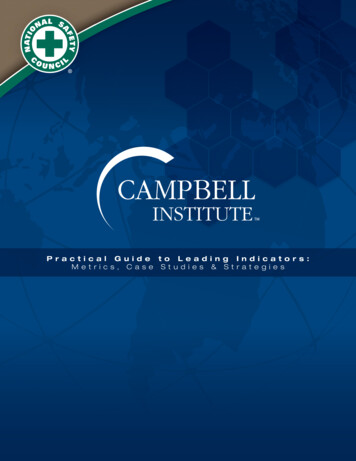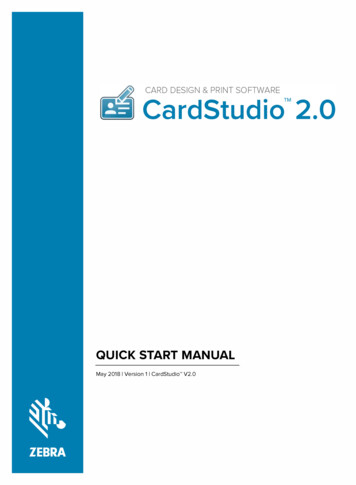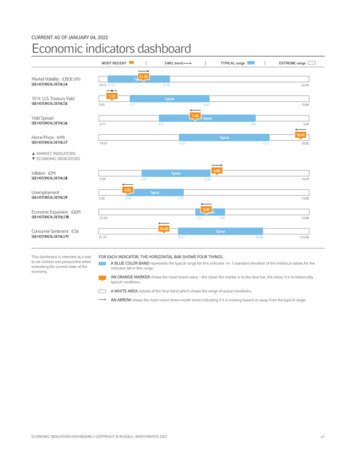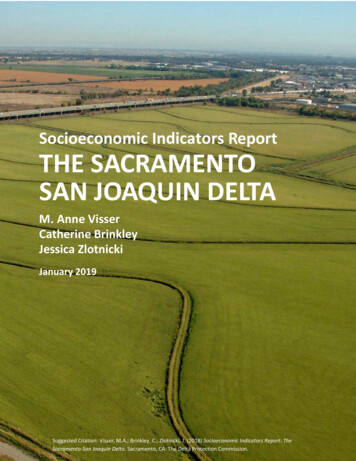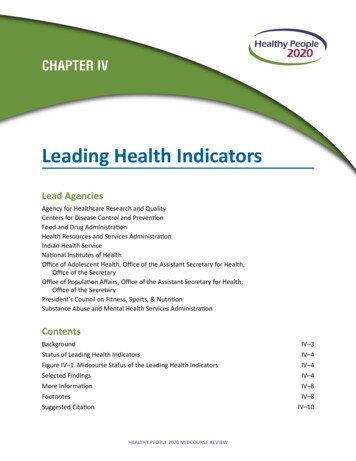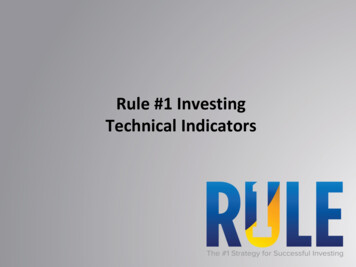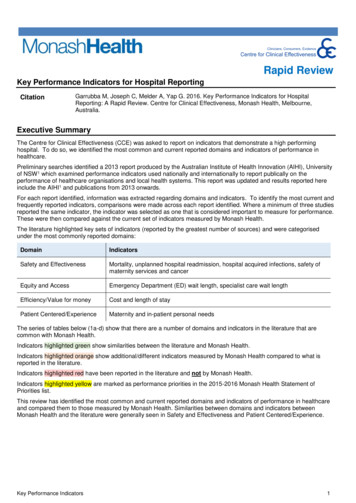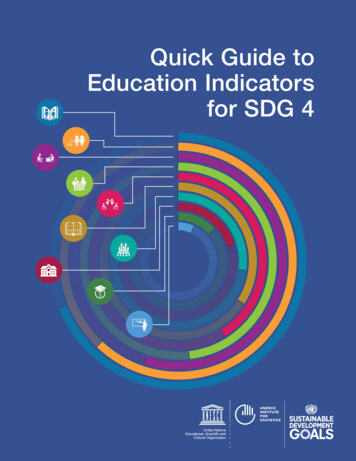
Transcription
Quick Guide toEducation Indicatorsfor SDG 4
Quick Guide to EducationIndicators for SDG 4
UNESCOThe constitution of the United Nations Educational, Scientific and Cultural Organization (UNESCO) was adopted by 20 countriesat the London Conference in November 1945 and entered into effect on 4 November 1946. The Organization currently has 195Member States and 10 Associate Members.The main objective of UNESCO is to contribute to peace and security in the world by promoting collaboration among nationsthrough education, science, culture and communication in order to foster universal respect for justice, the rule of law, and thehuman rights and fundamental freedoms that are affirmed for the peoples of the world, without distinction of race, sex, languageor religion, by the Charter of the United Nations.To fulfil its mandate, UNESCO performs five principal functions: 1) prospective studies on education, science, culture andcommunication for tomorrow’s world; 2) the advancement, transfer and sharing of knowledge through research, training and teachingactivities; 3) standard-setting actions for the preparation and adoption of internal instruments and statutory recommendations;4) expertise through technical cooperation to Member States for their development policies and projects; and 5) the exchangeof specialized information.UNESCO Institute for StatisticsThe UNESCO Institute for Statistics (UIS) is the statistical office of UNESCO and is the UN depository for global statistics in thefields of education, science, technology and innovation, culture and communication.The UIS was established in 1999. It was created to improve UNESCO’s statistical programme and to develop and deliver thetimely, accurate and policy-relevant statistics needed in today’s increasingly complex and rapidly changing social, political andeconomic environments.Published in 2018 by:UNESCO Institute for StatisticsP.O. Box 6128, Succursale Centre-VilleMontreal, Quebec H3C 3J7CanadaTel: 1 514-343-6880Email: rgRef: UIS/2018/ED/TD/4 UNESCO-UIS 2018This publication is available in Open Access under the Attribution-ShareAlike 3.0 IGO (CC-BY-SA 3.0 IGO) license /). By using the content of this publication, the users accept to be bound by theterms of use of the UNESCO Open Access Repository a-en).The designations employed and the presentation of material throughout this publication do not imply the expression of anyopinion whatsoever on the part of UNESCO concerning the legal status of any country, territory, city or area or of its authorities orconcerning the delimitation of its frontiers or boundaries.The ideas and opinions expressed in this publication are those of the authors; they are not necessarily those of UNESCO and donot commit the organization.
What is this guide?This guide serves as a quick reference on how to monitor progress towards Sustainable Development Goal 4(SDG 4) on quality education. It provides basic explanations of SDG 4 targets, their indicators, how they arecreated and where to find the information needed for these indicators.Table of contents1. What is SDG 4? . . . . . . . . . . . . . . . . . . . . . . . . . . . . . . . . . . . . . . . . . . . . . . . . . . . . . . . . . . . . . 72. What tools exist to measure progress towards SDG 4?. . . . . . . . . . . . . . . . . . . . . . . . . . . . . . . . 113. What is the UIS’ role in SDG 4 monitoring?. . . . . . . . . . . . . . . . . . . . . . . . . . . . . . . . . . . . . . . . . 174. How are SDG 4 indicators developed and calculated?. . . . . . . . . . . . . . . . . . . . . . . . . . . . . . . . . 204.1Free, equitable and quality primary and secondary education . . . . . . . . . . . . . . . . . . . . . . . . . . . . . 224.2Quality early childhood development, care and pre-primary education. . . . . . . . . . . . . . . . . . . . . . . 254.3Quality TVET and tertiary education. . . . . . . . . . . . . . . . . . . . . . . . . . . . . . . . . . . . . . . . . . . . . . . . . 284.4Technical and vocational skills. . . . . . . . . . . . . . . . . . . . . . . . . . . . . . . . . . . . . . . . . . . . . . . . . . . . . 304.5Equal access to all levels of education and training for the vulnerable . . . . . . . . . . . . . . . . . . . . . . . 324.6Youth and adult literacy and numeracy . . . . . . . . . . . . . . . . . . . . . . . . . . . . . . . . . . . . . . . . . . . . . . 344.7Knowledge and skills needed to promote sustainable development. . . . . . . . . . . . . . . . . . . . . . . . . 364.aSchool environment. . . . . . . . . . . . . . . . . . . . . . . . . . . . . . . . . . . . . . . . . . . . . . . . . . . . . . . . . . . . . 384.bScholarships. . . . . . . . . . . . . . . . . . . . . . . . . . . . . . . . . . . . . . . . . . . . . . . . . . . . . . . . . . . . . . . . . . 394.cQualified teachers. . . . . . . . . . . . . . . . . . . . . . . . . . . . . . . . . . . . . . . . . . . . . . . . . . . . . . . . . . . . . . 40Annex. Targets and indicators of Sustainable Development Goal 4 on education. . . . . . . . . . . . . . . . . 41References. . . . . . . . . . . . . . . . . . . . . . . . . . . . . . . . . . . . . . . . . . . . . . . . . . . . . . . . . . . . . . . . . . . . . . . . . . . 44UNESCO Institute for Statistics Quick Guide to Education Indicators for SDG 43
Acronyms4AESAdult Education SurveyCLACatalogue of Learning AssessmentsCONFEMENConférence des ministres de l’Éducation des États et gouvernements de la FrancophonieDACDevelopment Assistance CommitteeDHSDemographic and Health SurveyECLACUN Economic Commission for Latin America and the CaribbeanECDIEarly Childhood Development IndexEFAEducation for AllEMISEducation Management Information SystemESDEducation for sustainable developmentGAMLGlobal Alliance to Monitor LearningGCEDGlobal citizenship educationGEMRGlobal Education Monitoring ReportGPEGlobal Partnership for EducationGPIGender parity indexHLPFUN High-Level Political Forum on Sustainable DevelopmentIAEG-SDGsInter-Agency and Expert Group on SDG IndicatorsIAG-EIIInter-Agency Group on Education Inequality IndicatorsICTInformation and communication technologyIEAInternational Association for the Evaluation of Educational AchievementIIEPUNESCO International Institute for Educational PlanningIPUMSIntegrated Public Use Microdata SeriesISCEDInternational Standard Classification of EducationITUInternational Telecommunications UnionLaNALiteracy and Numeracy AssessmentLAMPLiteracy Assessment and Monitoring ProgrammeLLECELatin American Laboratory for Assessment of the Quality of EducationMDGMillennium Development GoalMELQOMeasuring Early Learning Quality and OutcomesMICSMultiple Indicator Cluster SurveyMPLMinimum proficiency levelNEANational Education AccountNEQMAPNetwork on Education Quality Monitoring in the Asia-PacificNGONon-governmental organizationODAOfficial development assistanceOECDOrganisation for Economic Co-operation and DevelopmentOOSCIUIS/UNICEF Global Initiative on Out-of-School ChildrenPASECProgramme d’Analyse des Systèmes Éducatifs de la CONFEMEN (CONFEMEN Programme for the Analysisof Education Systems)PIAACProgramme for the International Assessment of Adult CompetenciesUNESCO Institute for Statistics Quick Guide to Education Indicators for SDG 4
PILNAPacific Islands Literacy and Numeracy AssessmentPIRLSProgress in International Reading Literacy StudyPISAProgramme for International Student AssessmentPRIDIPrograma Regional de Indicadores de Desarrollo InfantilSACMEQSouthern and Eastern Africa Consortium for Monitoring Educational QualitySDGSustainable Development GoalSEAMEOSoutheast Asian Ministers of Education OrganizationSEA-PLMSoutheast Asia Primary Learning MetricsSLSShort Literacy SurveySTEPSkills Towards Employment and PorductivitySWTSSchool-to-Work Transition SurveyTCGTechnical Cooperation Group on the Indicators for SDG 4-Education 2030TERCETercer Estudio Regional Comparativo y Explicativo (Third Regional Comparative and Explanatory Study)TIMSSTrends in International Mathematics and Science StudyTVETTechnical and vocational education and trainingUISUNESCO Institute for StatisticsUNESCOUnited Nations Educational, Scientific and Cultural OrganizationUNICEFUnited Nations Children’s FundUNSDUnited Nations Statistics DivisionUNESCO Institute for Statistics Quick Guide to Education Indicators for SDG 45
Ami Vitale / The World Bank1. What is SDG 4?Heads of State, government leaders, UN high-level representatives and civil society met in2015 at the 70th Session of the United Nations General Assembly and adopted the 2030Agenda for Sustainable Development. This ambitious agenda, “of the people, by the people,and for the people,” was designed with the active involvement of UNESCO. Education plays acentral theme throughout the 2030 Agenda, which includes a stand-alone education goal andeducation-related targets within 7 other of the 17 Sustainable Development Goals (SDGs).SDG 4 aims to “ensure inclusive and equitable quality education and promote lifelong learning opportunities forall” by 2030. The goal consists of ten targets to guide countries along a transformative path to a sustainableeducation agenda.What is a target? A target is a specific, measurable objective which will contribute to achieving one or moreof the goals. SDG 4 has ten targets encompassing many different aspects of education. Among them, there areseven targets which are expected outcomes and three targets which are means of achieving these outcomes.How can the progress of SDG 4 be measured? SDG 4 has a broader focus than its predecessors, MillenniumDevelopment Goal (MDG) 2, “Achieve universal primary education” and MDG 3, “Promote gender equality andempower women”. From a statistical point of view, the MDG framework was built on a set of concrete, measurableindicators and helped to improve national capacity for monitoring in many developing countries. SDG 4 targets, onthe other hand, are more complex and contain several concepts that were never measured before at the globallevel, creating new challenges for developing the indicators which can monitor progress towards SDG 4.UNESCO Institute for Statistics Quick Guide to Education Indicators for SDG 47
What is an indicator? Indicators are markers of change or continuity which enable us to measure the path ofdevelopment, for example. Within the SDGs, they describe the way in which a given unit (pupil, school, countryor region) is progressing in relation to a specific target. SDG 4 indicators are multifaceted and many requirenew methodologies, definitions and calculation methods, as well as considerable changes to national systemsreporting data both nationally and internationally.What is the difference between a target and an indicator? If you have a personal target, say, to finish amarathon this year, a possible indicator to monitor your progress is the distance that you can run every day duringyour preparation. Achieving longer distances indicates that you are closer to your target.However, educational targets are much more complex than running 42 km and often more exhausting. A betteranalogy could be found in the process of learning how to play a new musical instrument. You might set a personaltarget of learning how to play the guitar this year. But how skilful will you need to be to say that you know howto play it? You may set a more specific target such as playing a particular song or learning how to play a givennumber of chords. Moreover, choosing one or more indicators to monitor your progress can be as complex as thetarget setting: Number of hours dedicated to learning? Number of chords or parts of the song that you know howto play? Your teacher’s feedback? The options are many, and the same is true for SDG 4 indicators.How are the SDG 4 indicators developed? Following several rounds of global consultations and meetingswith UN Member States, international and regional organizations, academia, businesses, non-governmentalorganizations (NGOs) and civil society, a list of 11 global indicators to monitor SDG 4 was formally adoptedby the UN General Assembly in 2017. With consensus reached on the list of global education indicators, a tierclassification tool was developed to identify the state of methodological development of each indicator and itsdata availability on a global scale. Tier 1 and Tier 2 indicators have internationally-established methodologies andstandards, but Tier 2 indicators are not available for a sufficient number of countries. Tier 3 indicators requirethe development of methodologies and standards, and this work has been prioritised by the Inter-Agency andExpert Group on SDG Indicators (IAEG-SDGs), a globally representative group of 28 national statistical expertsestablished by the UN Statistical Commission in 2015 to develop and implement a global indicator framework forthe monitoring of the SDGs. All indicators are considered equally important for monitoring SDG 4, independentof their tier classification.UIS Information Paper No. 45 (2017c) describes current procedures undertaken by the UNESCO Institute forStatistics (UIS) to develop education indicators from administrative and survey data.Are all countries and regions going to use the same indicators? SDG 4 monitoring is based on universalprinciples and emphasises a participatory framework in which all stakeholders (including civil society, business,parliament, academia and government) can recognise their shared responsibility in achieving the SDGs. Figure 1shows the multi-tiered, multi-purpose framework, which is composed of four monitoring levels—global, thematic,regional and national.Global level monitoring relies on a limited and carefully-selected group of leading indicators to providean overview of progress towards each target. The harmonisation of monitoring and reporting of SDGs forinternational comparability is also of critical importance. The ability to analyse and compare national data8UNESCO Institute for Statistics Quick Guide to Education Indicators for SDG 4
across countries and years provides insight into measuring performance, driving policy reform and allocatingresources equitably to improve learning among all population groups. The IAEG-SDGs, composed ofMember States and including regional and international agencies as observers, is responsible for the globalindicator framework development, as well as for its refinement and occasional revision. The IAEG-SDGs hasidentified the UNESCO Institute for Statistics (UIS) as the custodian agency for 9 of the 11 global indicatorsfor SDG 4 and a partner organization for the other two global indicators.Thematic monitoring adds a level of monitoring of cross-nationally comparable indicators within a specificsector (e.g. education, environment, energy, health) or cross-cutting themes (e.g. gender). Thematic indicatorsserve as a framework to track progress on a cross-nationally comparable basis, with a more in-depth viewof sectoral priorities than available in the global monitoring framework. This level provides the opportunityto identify sector-specific challenges and bottlenecks and mobilise the action required to address them.The thematic monitoring of SDG 4 follows the guidelines established by the Education 2030 Framework forAction, which was adopted by 184 UNESCO Member States in 2015. The thematic indicators for SDG 4 aredeveloped by the Technical Cooperation Group on the Indicators for SDG 4-Education 2030 (TCG), whichconsists of representatives of Member States, international agencies and civil society organizations. TheUIS hosts the Secretariat and co-chairs the TCG with the UNESCO Division for Education 2030 Support.At the regional level of monitoring, a set of indicators will be developed to consider priorities and issuesof common interest that are shared by countries in a particular region, as outlined in regional planningdocuments or frameworks. Different regions and sub-regions have reached agreements on certain goalsand targets even before the approval of the SDGs. A crucial step to promote efficiency and to avoid theduplication of efforts is to map the global and regional strategies. The UIS and the Global EducationMonitoring Report have produced a global overview of regional education monitoring, reporting andbenchmarking mechanisms:East Asia and the Pacific: Association of Southeast Asian Nations (ASEAN) —Work Plan on Education2016-2020; Pacific Islands Forum (PIF)—Pacific Education Development Framework; Southeast AsianMinisters of Education Organization (SEAMEO)—Education Agenda 2035; SPC Pacific Community—Education Quality Assessment Programme.Europe and Northern America: European Union (EU)—Education and Training 2020 (ET 2020).Latin America and the Caribbean: Caribbean Community (CARICOM)—Human Resource Development2030 Strategy; Central American Educational and Cultural Coordination (CECC)—Central AmericanEducation Policy (PEC); Organization of American States (OAS)—Inter-American Education Agenda;Organization of Eastern Caribbean States (OECS)—OECS Education Sector Strategy; Organization ofIbero-American States (OEI)—Metas 2021.Northern Africa and Western Asia: African Union (AU)—Continental Education Strategy for Africa2016-2025; Arab League Educational Cultural and Scientific Organization (ALECSO).South and West Asia: South Asian Association for Regional Cooperation (SAARC)—SAARC DevelopmentGoals: Taking SDGs Forward.UNESCO Institute for Statistics Quick Guide to Education Indicators for SDG 49
Sub-Saharan Africa: African Union (AU)—Continental Education Strategy for Africa 2016-2025; SouthernAfrican Development Community (SADC)—Process of update of Protocol on Education and Training /Regional Implementation Plan 2007-2015.Cross-regional organizations: Commonwealth—Commonwealth Education Policy Framework; IslamicEducational, Scientific and Cultural Organization (ISESCO)—Strategy for the Development of Education inthe Islamic World; Organisation internationale de la Francophonie (OIF); Organisation for Economic Cooperation and Development (OECD).National level monitoring of SDG 4 is linked to the needs of national and sub-national governments indeveloping education sector plans and informing policies. Data that provide high-level granularity and adaptto the specificities of the national context—such as in sub-national geographical units, specific disadvantagedgroups or by wealth—offer a greater capacity to inform policy by examining relevant disparities in educationoutcomes. Monitoring SDG 4 at this level benefits from the active participation of a diverse group of stakeholdersrepresenting their respective constituencies and education-related concerns. The UIS also works closely withnational governments and statistical agencies to support national strategies for data collection and to enableinternational reporting on all SDG 4 targets within the Education 2030 Framework for Action.Figure 1. Four levels of monitoring education targetsThematicRegionalSecretariat: UISTechnical Body: TCGUN Regional CommissionsNationalGlobalSecretariat: UNDESATechnical Body: IAEG-SDGsNational Statistical OfficesSource: UNESCO Institute for Statistics, 2016.The global and thematic education indicators were designed to facilitate cross-national monitoring of progresstowards the targets. Countries will be encouraged to report on both global and thematic indicators. Each countrywill determine whether it is able to collect all the data needed for each of the recommended indicators and toreport them as requested. Countries may choose from the list of thematic indicators that are most relevant fortheir policy needs. International organizations will continue to collect data from countries for cross-national comparisons and to report on trends.10UNESCO Institute for Statistics Quick Guide to Education Indicators for SDG 4
Bart Verweij / World Bank2. What tools exist to measureprogress towards SDG 4?Thereare several regional and international organizations which generate information on how to measurecountries’ progress towards SDG 4 targets. The coordination of the SDG data and indicator development at theinternational level is the responsibility of SDG custodian agencies.Custodian agencies are UN bodies (and in some cases other international organizations) responsible forcompiling and verifying country data and metadata and for submitting the data, along with regional and globalaggregates, to the United Nations Statistics Division (UNSD). The agencies ensure that the data are internationallycomparable and develop international standards and methodologies to help countries in monitoring. Country-leveldata may be published in their databases and used for thematic reporting.The institutional networkThe UIS has been mandated as the official source of cross-nationallycomparable data to monitor progress towards SDG 4 on education andkey targets related to science and culture. As defined in the Education2030 Framework for Action, the UIS works with partner organizations andexperts on the development of new indicators, statistical approaches andUNESCO Institute for Statistics Quick Guide to Education Indicators for SDG 411
monitoring tools to assess progress towards SDG 4 (UNESCO, 2016), in coordination with the Education 2030Steering Committee.This mandate reflects the trust of the international community in UIS data and its proven track record inmethodological work and standard-setting with national statistical offices, line ministries and technical partners inevery region.Some key initiatives coordinated by the UIS include:The Technical Cooperation Group on the Indicators for SDG 4–Education2030 ( TCG ) serves as a platform to discuss and develop the indicators used formonitoring SDG 4 targets in an open, inclusive and transparent manner. The TCG iscomposed of 38 regionally-representative statistical experts from Member States, international organizations, civilsociety and the Co-Chair of the Education 2030 Steering Committee.The Global Alliance to Monitor Learning ( GAML ) is designed to improve learningoutcomes by supporting national strategies for learning assessments and developinginternationally-comparable indicators and methodological tools to measure progresstowards key targets of SDG 4. Through a highly-collaborative approach, GAML brings together a broad range ofstakeholders, including experts and decisionmakers involved in national and cross-national learning assessmentinitiatives, as well as donors and civil society.The Inter-Agency Group on Education Inequality Indicators ( IAG-EII ) is set up to promote andcoordinate the use of household survey data for education monitoring at the national, regional and global levels.The IAG-EII is led by the UIS, UNICEF and the World Bank, and includes as members other organizations involvedin the production and use of household survey data: the Global Education Monitoring Report, Global Partnershipfor Education (GPE), ICF, the OECD, RTI International and USAID.The UN system has developed a wide support network for SDG monitoring at the global, regional and nationallevels. The specific roles of organizations in each level are detailed in Table 1.Data sourcesCountries are the starting point for all national and international monitoring. The players involved in data collectionand dissemination include the national statistical office, line ministries and other relevant national institutions.Countries determine the level of detail of data and metadata they share with custodian agencies and how much ofit is published. The more the data are disaggregated, the more useful they become for a wider range of audiences.The SDG global indicators represent only a subset of the full suite of indicators monitored in a country. Countriescan share additional datasets with custodian agencies and the United Nations High-Level Political Forum onSustainable Development (HLPF) through voluntary national reviews, for example.12UNESCO Institute for Statistics Quick Guide to Education Indicators for SDG 4
Table 1. Supportive role of the UN system, international organizations and major groupsGlobalRegionalNationalUN Secretary-GeneralRegional commissionsUnited Nations country team Global SDG Report Report on the work of the Regional fora on sustainable Support national/sub-national multi-organizationdevelopment Regional SDG reportsstakeholder consultations and reviews Play honest broker’s role to bringvarious government departments andmajor groups to one table to enhanceprogramme coordination and policycoherence Support mainstreaming of the SDGs andnational customization Support strengthening of evidence base(e.g. bottleneck assessments) Support national SDG reportpreparations Support the organization and coordinationof capacity development activities Support the collection, analysis andsynthesis of SDG-related data andevidenceUN Chief Executives Board Align work with the SDGs andemerging challenges UN system-wide policy coherenceRegional coordinationmechanism Programme coordination Policy coherenceMajor groups/civil society Thematic/sectoral national/sub-nationalreviews Reviews to enhance national ownershipand accountabilityInter-Agency and ExpertGroup on the SDGs and UNDepartment of Economic andSocial Affairs Indicator development Annual progress report SDMX, geospatial dataRegional inter-governmentalorganizationsü New Partnership for Africa’sUnited Nations Development Group Provide guidance for UN country teamsin support of the SDGsDevelopmentü Association of Southeast AsianNationsü South Asian Association forRegional Cooperation, etc. Peer reviews Lesson sharingOther UN Secretariat entities,UN specialised agencies andUN system organizations Thematic reviews/analysesRegional development banksü Asian Development Bankü African Development Bankü New Development Bank Analytical thematic reports/reviews Alignment of lendingOther multilateral organizationsand major groupsUnited Nations DevelopmentGroup Thematic reviews/analyses Regional/country programme reviews Regional reviews and capacityUnited Nations DevelopmentGroupdevelopment Country progress reports/reviews National thematic reports/reviewsSource: United Nations Development Group (UNDG), 2017.UNESCO Institute for Statistics Quick Guide to Education Indicators for SDG 413
Administrative data. Every year, the UIS conducts surveys on formal education programmes and educationalattainment and every two years a survey on literacy. These surveys consist of a set of questionnaires oneducation programmes, students, financial and human resources, literacy and educational attainment, whichare reported according to international standards to assure cross-country comparability. The main data sourcesare administrative records from school surveys or aggregate data from labour force or household surveys. Thequestionnaires are sent to national statistical offices and ministries of education in each country. The results fromthese questionnaires are the source of many SDG 4 indicators.Data on education finance and expenditure are essential to effectively address critical education policy questions.Data on public and international education expenditure are derived from administrative records compiledtypically by the Ministry of Finance, Ministry of Education or national statistical offices. In 2016, the UNESCOInternational Institute for Educational Planning (IIEP) and the UIS jointly developed a methodology on NationalEducation Accounts (NEAs), a comprehensive, systematic and comparable framework for collecting, processingand analysing data on education expenditure (IIEP, UIS and Pôle de Dakar, 2016). Data on private householdexpenditure are derived from household budget surveys usually administered by national statistical offices.Household surveys. The UIS compiles and disseminates household survey data to produce indicators toexamine specific characteristics of populations, which are generally only available through these sources. Datasetsfrom household surveys are gathered from international programmes, such as the Demographic and HealthSurvey (DHS) and the Multiple Indicator Cluster Survey (MICS), as well as from survey repositories of organizationssuch as the UN Economic Commission for Latin America and the Caribbean (ECLAC), the Integrated Public UseMicrodata Series (IPUMS) and the World Bank. These data are used to calculate various education indicators,such as school attendance and completion rates.Learning assessments. The UIS identified nine cross-national learning assessments which meet the criteriato measure SDG 4 Indicator 4.1.1, the proportion of children and young people achieving minimum proficiencyin reading and mathematics: LaNA (Literacy and Numeracy Assessment), PASEC (Programme d’Analyse desSystèmes Éducatifs de la CONFEMEN), PILNA (Pacific Islands Literacy and Numeracy Assessment), PIRLS(Progress in International Reading Literacy Study), PISA (Programme for International Student Assessment),SACMEQ (Southern and Eastern Africa Consortium for Monitoring Educational Quality), SEA-PLM (SoutheastAsia Primary Learning Metrics), TERCE (Tercer Estudio Regional Comparativo y Explicativo) and TIMSS (Trends inInternational Mathematics and Science Study). Using these data sources, the UIS has calculated key indicatorsrelated to learning outcomes for SDG 4.The UIS (2018) has drafted a proposal for an education-focused platform called edu2030/countrySTAT in the formof a Global Data-Sharing Network that positions countries at the centre of the initiative and addresses their needsin developing data for SDG 4. Easily accessible online, it would enable researchers, policymakers, developmentorganizations and the private sector to design and implement better policies and reduce transaction costs andinformation gaps.14UNESCO Institute
through education, science, culture and communication in order to foster universal respect for justice, the rule of law, and the . The UNESCO Institute for Statistics (UIS) is the statistical office of UNESCO and is the UN depository for global statistics in the . 4.4 Technical and vocational skills .
